“I have aged phenomenally,” Bruce Wayne confesses about half-an-hour into The LEGO Batman Movie.
He is not wrong. The LEGO Batman Movie is in many ways an overt celebration of the legacy of the Caped Crusader, the pop culture icon who remains one of the most recognisable figures in the world. Repeatedly over the course of the film, character reference Batman’s rich history, from the Joker’s confession that they have known each other for “seventy-eight years” or Alfred’s reference to “that weird [phase] in 1966” or even Barbara Gordon’s slideshow presentation that goes back to the cover of Detective Comics #27 and the forties film serial.

Holding it all together…
The framework of The LEGO Batman Movie allows the characters and the script to comment upon the Batman mythology. The script is crammed with references from the length and breadth of the character’s publication history, from “Bat shark repellent!” to particular costume styles to minor villains to musical cues to fourth-wall-breaking references to other media that has inspired various interpretations of the Caped Crusader. This allows The LEGO Batman Movie to be explicitly about Batman in a way that few Batman stories can be.
As such, The LEGO Batman Movie offers a very broad summary of the Batman mythology and characters, surveying decades of printed and screen material to reduce Batman to his most simply and essential qualities. The LEGO Batman Movie offers a very compelling portrait of Batman as a man so traumatised by loss that he never allowed himself to grow up, while somehow subconsciously cultivating a family around himself. For all the character’s lauded darkness, The LEGO Batman Movie celebrates the hope at the heart of that mythology.

Welcome to his man-cave.
To be fair, this is hardly a provocative or insightful observation about Batman as a character. This is particularly true within the source material, in which Batman has assembled an entire “Batfamily” that is comprised of multiple characters carrying the “Batbranding.” Over the years, there have been dozens of Robins, quite a few Batgirls, a couple of Batwomen. This is to say nothing of peripheral supporting characters like Alfred Pennyworth or James Gordon or Azrael or even Superman.
This idea of Batman constructing a family spilled over into other media as well. Batman! focused on “the dynamic duo” and introduced the entire concept of Batgirl. Batman: The Animated Series did an excellent job cultivating that expanded family across its run. Batman: The Brave and the Bold is a series that is quite literally about how awesome Batman is and how many super-friends he has from Aquaman to Green Arrow to Metamorpho. Anybody with even a passing familiarity with Batman understands the importance of the family.
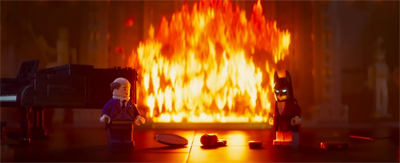
Keeping the home fires burning.
However, there is a reason that this facet of Batman has been downplayed in the popular imagination in recent years. Since the eighties, there has been a very strong tendency to treat Batman as a loner. Frank Miller is probably to blame in some way, for pointing out in The Dark Knight Returns that it was only a matter of time before Batman got a child killed, even if Miller also took the time to introduce a new version of Robin. That said, the character’s transition to live-action probably played a bigger role in this shifting perception.
When Tim Burton brought Batman to the big screen in Batman and Batman Returns, he noticeably streamlined the mythology to separate it from the bright aesthetic of the sixties television show. He also made an effort to portray Bruce Wayne as a character isolated and withdrawn, a loner living in a creepy mansion with his British manservant who was incapable of living a normal life because of the weirdness inside of him. There was a sense that characters like Robin and Batgirl were superfluous to the larger mythology.

Pilot error.
It probably doesn’t help matters that the attempts to introduce Robin and Batgirl into the cinematic franchise in Batman Forever and Batman and Robin were spectacular failures that derailed the entire franchise before becoming critical punchlines. Of course, the awfulness of those two movies has little to do with the addition of those two characters, but their presence served to confirm that the public liked the idea of a lonely and isolated version of Batman.
At the same time, the comic books of the eighties and nineties took great pains to isolate Batman and push him away from his supporting cast and allies. Robin does not appear in Arkham Asylum: A Serious House on a Serious Earth. Batgirl is paralysed by the Joker in The Killing Joke. A Robin is killed by the Joker in A Death in the Family. Another Robin is killed by the Black Mask (!) in War Games. Bruce alienates the Justice League in Tower of Babel. His jerkish isolation is a plot point in both Knightfall and No Man’s Land.
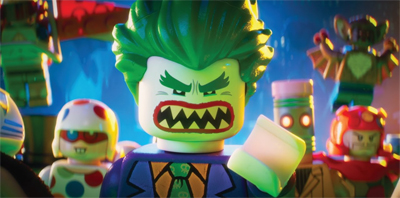
Love that Joker!
The colossal success of Christopher Nolan’s trilogy of Batman films only reinforced this. Bruce Wayne did develop a surrogate family over Batman Begins, The Dark Knight and The Dark Knight Rises, but it was very much at a remove. More than that, Nolan suggested that Batman was very much an impediment to Bruce ever having a functional family unit; Batman drives Alfred away, and Bruce only finds peace with Selina and fully embraces John Blake after faking his own death. While there was a “Robin”, it was not a conventional Robin.
This is part of the reason why The LEGO Batman Movie feels so refreshing in the broader context of cinematic Batman stories. It is very much a Robin story, in that is essentially a massive justification for the existence of the sidekick – and of the extended family. The LEGO Batman Movie is essentially an extended essay on what Robin (and other costumed supporting cast members) bring to the larger Batman mythos in terms of building a family around Bruce Wayne. After all, Bruce Wayne is a lost child who builds a fantasy around himself.

On lockdown.
Much like The LEGO Movie before it, The LEGO Batman Movie builds upon the idea of Batman as a jerkish and stand-off-ish loner with no real emotional connection to anybody. In some ways, this is an extension of the kind of Batman cultivated by directors like Tim Burton and Christopher Nolan, and explored (and even deconstructed) by writers like Greg Rucka and Ed Brubaker. Will Arnett is fantastic in the role, taking the recurring idea of Bruce as a child who never grew up and pushing it to its extreme.
The narrative at the heart of The LEGO Batman Movie is very much typical family movie fare. The jerkish loner comes to realise (and value) the people around him, accepting that he cannot work alone. Bruce adopts the orphan Dick Grayson. Batman comes to term with Commissioner Barbara Gordon wanting Batman to “team up” with the police force. Batman even comes to understand how horribly he has treated his “greatest enemy”, with the Joker’s sense of rejection spurring the entire plot.
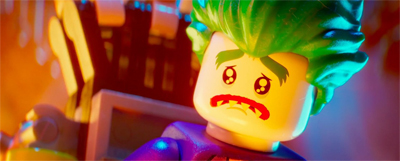
The day the clown cried.
And, to be fair, The LEGO Batman Movie is smart enough and self-aware enough that it works on those terms alone. As a standard feel-good family film about the moral of cooperation and companionship, The LEGO Batman Movie works very well. It is funny without being cynical, it is witty without seeming detached. It walks a fine line between being too simplistic and undercutting the universality of its core theme. It is a very good family film on its own terms, even if its ideas are very straightforward.
However, it is an exceptional tribute to Batman. The LEGO Batman is built with an incredible amount of love and affection for the character and his history. This is a Batman movie that takes the time to blend obscure Batman villains like Crazy Quilt or the Condiment King alongside a very Tom Hardy inspired version of Bane. (“That was unnecessary,” Bane pompously declares after a cheap shot, sounding like Rex Harrison filtered through a gimp mask.)

It takes a lot of work to make eating lobster seem pathetic, but The LEGO Batman Movie gets there.
The film is a laundry-list of references drawn from the character’s history. Virtually every Batmobile ever appears, from the vintage forties design to the Schumacher model. “Let’s get nuts,” Batman declares upon throwing himself into the fray, channeling his inner Michael Keaton. Alfred passive-aggressively lets outsiders wander into the Batcave in the style of Michael Gough. “We’re going to punch them so hard that sound effects will spontaneously appear,” Batman advises his sidekick at one point. The Joker even has tattoos.
(There is even a certain strain of passive-aggressiveness directed at the recent efforts made by “the house that Batman built” to build a shared cinematic universe. At one point, a character suggests that Batman might team up with his adversaries to fight a bigger threat. “A team of bad guys to fight the bad guys?” Batman responds. “What a stupid idea.” At another moment, Batman reflexively cites “Superman” as his “greatest enemy.” There is even a gray scale recreation of the climax to Batman vs. Superman.)

Shades of grey.
However, the references extend even into the production. The design of the bridges in Gotham very much resembles Chicago as presented in Batman Begins and The Dark Knight. Wayne Manner is laid out so as to recall the classic Tim Burton movies. The soundtrack makes various subtle and not-so-subtle nods to classic Batman soundtracks, although The Dark Knight Rises is a very heavy influence upon the film’s score. Some John Williams plays when Batman visits Superman’s “Palace of Loneliness.” This is a very referential film.
Indeed, the movie even nods towards the comic book source material. Panels are lovingly recreated, while Barbara Gordon is given a back story that very closely resembles Dick Grayson’s character development from the nineties comic books. The emphasis on Batman coming to terms with his “son” plays like a nod to the work of Grant Morrison, while the climax of the film that sees Batman teaming up with some of his most iconic foes to stop a deranged Joker feels like an overt reference to Scott Snyder and Greg Capullo’s Endgame.

Yeah, Batman. We were as disappointed with Batman & Robin as you were.
However, these are not references for the sake of references. Instead, they exist to contextualise The LEGO Batman Movie as a loving tribute to Batman. There is a sense that these characters have somehow lived through all the myriad continuities and stories across the nearly eighty-year history of Batman. Characters reference the Joker’s plot with “the two boats” from The Dark Knight or “the parade with the Prince music” from Batman, making it clear that these are things which the characters remember.
There is something very endearing about this touch, particularly in an era fixated upon the “shared universe” or the demands of “continuity.” In many ways, The LEGO Batman Movie eschews the idea of a single cohesive continuity by instead suggesting that every Batman story ever in any medium contributes to the growth and development of the character; to the shaping and defining of what these characters are in the popular consciousness. Batman is not just Christian Bale or Ben Affleck; he can be both, he can be neither.

Blast from the past.
There is something very energetic about this, something that fits perfectly with the idea of The LEGO Batman Movie as a movie about playing with familiar toy. Like The LEGO Movie before it, The LEGO Batman Movie captures some of the joy of being a child playing with toys, unconstrained by rules or expectations, free to let imagination run wild. Indeed, one of the nicer animation effects is the recurring hint of scratches on the characters, reminding us that these versions of Batman and the Joker are essentially well-played-with toys.
There seems to be a heavy influence of writer Grant Morrison on The LEGO Batman Movie, most obviously in its expansive and all-consuming approach to continuity, but even within its storybeats. Grant Morrison wrote a seven-year epic on Batman, in which he explored the key themes and ideas of the character. Although The LEGO Batman Movie is obviously much smaller in scope, it still hits upon those same ideas about Batman as a mythology and as an idea, and the balance between darkness and hope within that mythology.
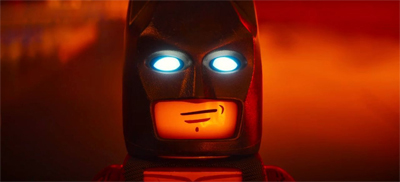
Masking his emotions.
This is perhaps most telling in where those stories both choose to start. Grant Morrison opened his first issue of Batman by having Bruce Wayne apprehend the Joker, and lock him away with all the traditional villains. This allowed the writer to focus on broader themes about what Batman was about when he wasn’t defined by his iconic rogues’ gallery. The LEGO Batman Movie does something similar, at least in its first two acts when it engages an existential exploration of what it must mean to be Batman beyond punching bad guys.
More than that, both Grant Morrison’s Batman & Son and The LEGO Batman Movie ask questions about what it means for Batman to be a father and how the character needs to grow up to meet those expectations. Robin has always been treated as a surrogate son for Bruce Wayne, but both Batman & Son and The LEGO Batman Movie render the metaphor explicit. On a more superficial note, The LEGO Batman Movie works in a cameo for “the Bat Shuttle!”

It’s good to be bad.
To be fair, The LEGO Batman Movie does come off the rails a bit when it reaches the climax. For all that the movie is about Batman learning that he doesn’t need to be so dark and cynical, it does lead to a typically bombastic finale that feels a little cluttered. Most obviously, Batman essentially learns the same lesson repeatedly about the value of counting upon his friends. The LEGO Batman Movie spends so much time on Batman and his colleagues that the villains feel under-explored, particularly the nuances of the Joker’s plans and motivations.
However, The LEGO Batman Movie over-eggs the pudding by insisting that Batman’s enemies are part of his family. This is an interesting approach that certainly has some merits. Batman has repeatedly been shown to believe in redemption for his adversaries; consider Clayface in the recent Detective Comics run or various characters in The Animated Series. More than that, compassion and understanding are virtues that really deserve to be celebrated, particularly in the context of a broader culture that is so fragmented and divided.
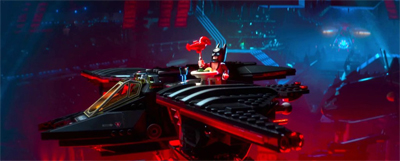
Chewing it over.
However, there are two problems with this suggestion. The most obvious is that Batman’s villains are largely defined by their unpredictability and their psychosis. Unlike other supervillains like Lex Luthor or Sinestro, Batman’s enemies are not rational. The LEGO Batman Movie bends over backwards to insist that Batman’s enemies don’t kill people, with the Joker sticking parachutes on captives and balking at Sauron’s threat to make the rivers run red with blood, but the film does see the Joker plotting to plunge Gotham into an abyss.
More than that, the suggestion that Batman needs to embrace and love his enemies also creates certain storytelling problems. The climax of The LEGO Batman Movie requires an apocalyptic action spectacle, and that means that there must be bad guys. As such, the Joker drafts in characters like King Kong and some suspiciously familiar “British robots” who will destroy Gotham. However, is King Kong any less sympathetic than Bane? If Batman is friends with everybody, then what is the point of Batman?

Whatcha got cooking?
These questions are arguably too much, subjecting a broadly-drawn family film to an unfair level of scrutiny. However, The LEGO Batman Movie is so well-observed and so self-aware that these issues in the final act are distracting. The rest of the film is so clever and so well constructed that these storytelling choices feel overly simplistic and shallow. There is a much more satisfying ending to this story, but The LEGO Batman Movie opts for the most reductive interpretation of its core themes.
Still, this minor issue aside, The LEGO Batman Movie is a fun and loving tribute to the long history of the Caped Crusader. It is a valid addition to the canon, and a reminder Batman is more than just “black… or very, very dark grey.” It is an interpretation as valid as any other, and more striking for the contrast that it presents with the character’s recent big-screen appearances.
Filed under: Non-Review Reviews | Tagged: batman, Lego, Movie, non-review review, review, the lego batman movie |




















Can’t wait to see this movie looks hilarious
I hope you enjoy!
It was a fun movie, very funny.
I hadn’t really thought about it before but it amazing how shallow the roots of Batman as a ‘loner’ really are. Bruce Wayne was fighting crime solo for all of a year (in real terms) when Dick Grayson showed up in 1940 and then stuck by his side for over four decades. It isn’t only Robin though; Batman was also best friends with Superman for thirty years from the Eisenhower Era to the Reagan Era.
It is very weird the default Batman has somehow turned into a man who works alone.